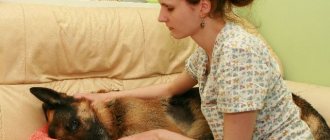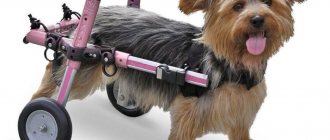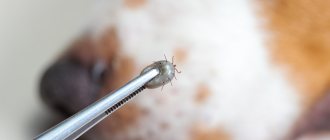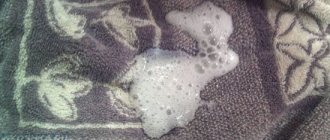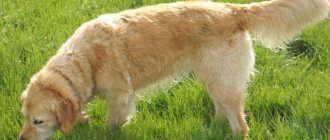Vascular lesions in the brain in dogs are diagnosed much less frequently than in humans. But at the same time, strokes in dogs lead to the same serious complications in the functioning of the animal’s body as in humans.
The danger of a stroke in a pet is that the owner can easily miss the first signs of the pathological process. It is important to understand how a stroke manifests itself in dogs, how to provide first aid to an animal, and what preventive measures need to be taken to avoid the development of vascular damage in the brain.
Stroke is a serious medical condition that is an emergency. Problems with blood vessels in the brain have a sharply negative impact on the functioning of the entire body, causing dangerous neurological disorders, sometimes incompatible with normal life.
In veterinary medicine, as well as in human medicine, there is a rule according to which care provided for a stroke in the first 2-3 hours after the onset of the condition has a positive effect, and the prognosis is more likely to be favorable.
What is a stroke and a microstroke?
First, a little terminology. Stroke (from the Latin insultus “blow”) is an acute disorder of cerebral circulation, leading to the gradual death of cells and the death of entire parts of the brain.
Depending on which part of the brain is damaged, after a stroke the tailed patient loses the ability to move normally and perform functions usual for healthy animals.
There is also such a thing as a microstroke - a harbinger of a real major stroke. In the case of a transient ischemic attack, which is what, according to medical terminology, is called a microstroke, the congestion formed in the vessel resolves on its own without medical assistance. However, several micro-strokes are comparable to one large blow and also carry dangerous irreversible consequences.
What not to do!
When providing emergency care, it is important not to make the following mistakes:
- Do not apply cold to your head under any circumstances! Once upon a time this was often recommended. It has now been proven that this action not only does not bring anything useful, but can also cause harm, causing spasm of blood vessels, both already damaged and healthy, worsening the condition after a stroke.
- It is forbidden to try to give any pills without the instructions of a specialist!
- You should not give your dog any injections unless directed by your veterinarian!
Causes of stroke
The causes of stroke in dogs are:
- heart pathologies;
- hypertension;
- obesity;
- autoimmune diseases;
- traumatic brain injuries, concussions;
- severe helminth damage affecting the brain;
- poisoning;
- poor functioning of internal organs, for example, the thyroid gland, kidneys, liver;
- aneurysm or other vascular abnormalities;
- blood thickening;
- atherosclerosis;
- hormonal disbalance;
- severe shock or stress;
- tumors in the brain.
How to recognize a disease in a four-legged animal
It is important to notice the first signs of a stroke as soon as possible in order to begin treatment in a timely manner.
The main sign of cerebral hemorrhage is paresis or paralysis of the paws and other parts of the muscular system. The remaining symptoms are very similar to other disorders in the brain and circulatory system.
To determine the cause of the animal’s poor health, the doctor performs detailed neurological studies, analyzes blood and urine. If necessary, an ultrasound examination of the abdominal area, X-ray of the lungs, CT or MRI is performed. An electroencephalogram and cerebrospinal fluid analysis are often used.
Symptoms of the disease
The following signs will help you recognize a stroke in your pet in time and seek help from a veterinarian:
- the dog has become unusually lethargic, apathetic, or, on the contrary, overly active and even aggressive;
- the animal does not respond to its name, as if it does not recognize you, it looks confused;
- the dog has problems swallowing food and water;
- a clear asymmetry appeared on the muzzle;
- the pet begins to limp or lies completely motionless;
- labored breathing;
- convulsions, seizures resembling epileptic ones;
- dilation of one or both pupils;
- vomit;
- coma.
Canine microstroke is not characterized by such striking manifestations. However, if your pet refuses food, behaves strangely, for example, wanders aimlessly in circles around the apartment, refuses to go outside - immediately go to see a doctor.
Prevention
Animals that have a genetic predisposition to vascular disease, adult dogs must be shown to the veterinarian every 6 months - the doctor will select a diet and exercise to prevent the development of stroke.
Proper nutrition is the key to a dog’s health; the diet should contain more vitamins, vegetables, and raw meat. Sweets, salty foods, food from the human table are absolutely not suitable for animals, as they provoke the development of obesity. Owners should not allow their pets to become physically inactive - long walks, training, training, and active games help strengthen the heart and blood vessels.
Canine stroke is a rare but very dangerous disease that requires long-term treatment and recovery. Without timely and correct help, serious consequences develop - complete or partial paralysis, death of the pet, only a doctor can diagnose, carry out emergency therapy, and tell what to do at home. Regular visits to the veterinarian, proper nutrition, regular moderate exercise - these simple measures significantly reduce the risk of cerebral hemorrhage in your pet.
Types of stroke
There are two types of stroke: ischemic and hemorrhagic.
- An ischemic stroke or cerebral infarction provokes a disruption of the blood supply. Ischemic stroke occurs four times more often than hemorrhagic stroke. The main culprit of this scourge is a diseased heart, which has lost the ability to pump blood well and deliver it to the internal organs, including the brain.
- Hemorrhagic stroke, in turn, is characterized by rupture of a vessel and release of blood into the intracranial space. And although this type is the least common (occurs in only 25% of cases), it leads to the most severe consequences.
Question answer
Is it possible for an old dog to have a stroke?
Older animals often develop increased fragility of blood vessels, so hemorrhagic brain damage may well occur. Also, older individuals already have various diseases in old age, which can also provoke brain failure. For animals older than 5-7 years, it is better to undergo an annual medical examination to assess their general health and identify all potential risks for it. Strokes in very old dogs (over 11-13 years of age) are often fatal.
Stroke in a dog - is treatment possible at home?
Self-medication is strictly prohibited! The first three days are considered the most critical, so during this time it is recommended to keep the animal in the hospital for therapy under the supervision of a specialist. If the dynamics are positive, you can continue treatment at home, but with strict adherence to the veterinarian’s recommendations. If the animal does not respond positively to treatment, the prognosis is unfavorable.
Are there special medications for stroke in dogs?
No, there are no special drugs for strokes. Treatment is carried out with a whole complex of various drugs that stabilize the animal’s condition as much as possible.
First aid for ischemic stroke in dogs
The most rational assistance from the owner will be to quickly deliver the dog to the veterinarian. Place the animal on its side on any hard surface, remove the collar, hold its head in a position on its side, check its mouth so that nothing interferes with the animal’s breathing (saliva, vomiting), stroking and talking calmly. No pills or injections are allowed! A maximum of 5 drops of valerian or motherwort tincture with water is allowed for calming. It’s great if you can call a veterinarian at home.
What to feed a dog after a stroke?
In severe cases of stroke with paralysis and inability to swallow, the dog must be fed in a hospital with the help of IVs. After swallowing functions are restored, feeding is carried out using a syringe or rubber bulb with liquid, puree food.
In general, it is better not to change your diet, but you can reduce your fat intake. Ideally, this is chicken broth with the addition of various grated boiled vegetables, chicken or beef, beef liver, and oatmeal. It is better not to give buckwheat and rice cereals at the beginning of the recovery period. If possible, you can add ready-made industrial food for sick and weakened animals in the form of pates dissolved in any weak and low-fat meat broth to the regular diet.
It is better to feed more often, but in small portions - up to 5-6 times a day. Usually appetite is restored quickly; the problem may persist only in restoring the function of the chewing and swallowing muscles.
How quickly does a dog recover after a stroke?
The speed of recovery of the animal’s general condition and impaired nervous functions depends on many factors: age and health status at the time of the development of the disease, the location of the hemorrhage or ischemia and its area, whether the cause was identified and how quickly first medical aid was provided. The younger and healthier the dog, the smaller the volume and severity of damage to the brain vessels, the greater the chances for a quick and complete recovery. In severe cases, treatment can take 6-8 weeks, and rehabilitation – up to 1 year.
Stroke or peripheral vestibular syndrome in a dog?
Very often, stroke is confused with a pathology such as peripheral vestibular syndrome. These are two different conditions, although outwardly the clinical signs are somewhat similar. The syndrome occurs in individuals over 8 years of age, it is not associated with vascular pathologies and does not affect the central nervous system in the same way as it does with ischemia or hemorrhage. Treatment regimens differ significantly. Precisely because the conditions are similar, a visit to the veterinarian is mandatory, because Only a specialist can distinguish the signs of a stroke from the syndrome.
Author:
Grinchuk Ekaterina Andreevna veterinarian
Who gets a stroke more often than others?
It should be noted that dogs are less susceptible to this terrible scourge than we are. Animals have fewer bad habits: they do not smoke, do not drink alcohol, but it is these human addictions that become the main provocateurs of stroke.
However, dogs also have their own risk group. It includes:
- older dogs;
- excitable dogs with unstable psyches;
- large breeds;
- animals prone to heart disease, for example, Boxer, St. Bernard, Malamute.
Risk group
Dogs at risk include:
- old age, due to age-related thinning and fragility of the walls of blood vessels;
- large breeds;
- fighting breeds;
- aggressive and embittered;
- experiencing frequent stress;
- living in environmentally unfavorable conditions;
- having excess weight.
Veterinarians primarily consider older pets to be at risk.
What common neurological diseases of dogs “masquerade” as a stroke?
There are several diseases that are often confused with stroke because their symptoms are incredibly similar:
- Peripheral vestibular syndrome. It is this that is more often than other ailments mistaken for a stroke. The exact causes of the development of this disease have not yet been identified, but it is believed that the main “lever” is age-related changes in the vestibular apparatus. In the absence of obvious organic lesions, the animal seems to be lost in space and ceases to distinguish the horizon line. The dog falls, walks in a circle, holds its head at an angle. Asymmetry appears on the muzzle, the eyes constantly move from side to side.
- Central vestibular syndrome. In appearance it resembles peripheral, although in this case the zones of the pons, medulla oblongata and vestibular nuclei are affected. The main sources of troubles are cysts and other neoplasms affecting these parts.
Please note that only an experienced veterinarian can make an accurate diagnosis after a thorough diagnosis.
The first signs of a stroke in a dog
As with humans, the first 2 hours after a stroke are most important. If you recognize everything in a timely manner, you can save your pet in time:
- If there is no response to the name or commands cannot be executed. The brain simply cannot give a command to the body, although the dog understands everything and looks confused.
- Having trouble breathing or swallowing. The smooth muscles of the pharynx also refuse to work, but this is usually a temporary effect.
- The dog began to show excessive apathy or aggression towards everyone indiscriminately instantly.
- Lameness occurs in one or more limbs, the pet may lie motionless, sometimes whining a little.
- If you look at the muzzle directly along the line of symmetry, you will notice a certain violation. Be sure to look at the position of the eyebrows and upper lip, as well as the orientation of the eyes.
- Heart arythmy. This can only be heard with a stethoscope, especially in breeds with thick coats.
- The animal seems to be unable to concentrate its vision, and the eyes look in different directions or the pupils are not the same size.
- There are constant attacks of nausea and vomiting. They are not controlled, perhaps even in their sleep.
- The dog may fall into a brief state of unconsciousness, similar to sleep, but with weaker breathing and a slower heart rate. She may lie on her side or walk, but completely unaware of her own actions.
If this happened on the street, you need to take the animal without changing the position of the body, it is advisable to use a stretcher. And then transport him to a veterinary clinic as soon as possible. Typically, patients with such symptoms are treated without waiting in line.
Prohibited actions
It is important that at home it is strictly forbidden to “treat” the dog yourself and prescribe it medications and drugs, especially human ones. You should also not put ice or cooling bandages on your pet’s head. Cold provokes spasm of the head vessels and will complicate the situation.
Medical assistance should only be provided by a doctor, so at the first symptoms, immediately go to a veterinary hospital. The first three hours are the most important to saving your dog.
Before transportation, you will have to relieve the animal's condition. To do this you need:
- Remove the collar from your neck.
- Give the animal water.
- If the dog is overly excited and scared, you can add herbal sedatives to the water, for example “Bayun”, “Fidex”.
- In the car, be sure to place your pet on its side so that if it becomes nauseous, it does not choke on vomit.
- If your dog is drooling a lot, wipe the dog's mouth with a napkin or bandage.
- Be sure to talk to your pet in a quiet, calm voice the whole way, calm him down by gently stroking him.
Providing independent first aid
Treatment in this case does not require delay - you should immediately get help at home. Even if you worry in vain, help will be useful. The main thing is not to delay it and not cause harm by performing meaningless and unprofessional actions. The best option would be to call the veterinary clinic and provide first aid under the guidance of a doctor.
What can you do with caution?
If you feel like you don't have time to make a call, follow these simple steps
:
- remove the collar and anything that may interfere with breathing and movement;
- Lay the sick person on his side - the head area should be in a comfortable position (in case of nausea);
- if vomiting was observed, then all secretions should be removed from the mouth;
- Talk quietly and kindly to your pet, calming him and stroking him.
Never give medications without a doctor's prescription. You can only use herbal sedatives - again, with the approval of the veterinarian at the other end of the line. The main thing is that the liquid does not enter the respiratory system. Do this with a syringe without a needle.
What is prohibited to do
Some actions of owners can harm the pet, so you should be well aware of what not to do:
- You cannot give water to an animal if it is unconscious or has convulsions, foam at the mouth, or vomiting;
- under no circumstances give any medicines or give injections until the doctor himself says so;
- do not cool the sick person’s head and do not wrap him up to prevent overheating;
- Don’t create panic, noise and fuss: this will only make the situation worse.
Ideally, you should first call the veterinarian, and then carry out the treatment measures that he recommends.
Modern approaches to the treatment of disease in veterinary clinics
After all diagnostic measures and a comprehensive examination, the veterinarian will make a diagnosis and only then prescribe treatment. If a stroke is confirmed, the dog will be prescribed anticonvulsants, painkillers, drugs that restore cerebral circulation, vitamins, antipsychotics, and tranquilizers.
Most likely, the animal, especially in serious condition, will remain in the hospital for several days under the supervision of staff. As soon as the patient’s condition has stabilized, he will be discharged home under the responsibility of his owners. Owners will have to strictly follow all doctor's instructions and adhere to the prescribed medication regimen.
What symptoms are important to pay attention to?
Only a specialist can confirm the diagnosis. The clinical manifestation can be rapid, right up to coma, or can be observed within 1-3 days. But the owner’s attention should be drawn to the following signs and symptoms in a dog that are characteristic of a stroke:
- Asymmetry of the muzzle, drooping lips on one side and protruding tongue.
- Changes in the diameters of the pupils (one becomes larger, one becomes smaller).
- Visual impairment (the pet bumps into objects, stumbles over thresholds).
- Pointless walking, often in circles. Moreover, each time the diameter of the circle of movement will become smaller and smaller, up to the point of spinning in one place. The dog may begin to back away sideways.
- Paralysis of the limbs may be observed - only the left/right side or the front/hind legs. Complete paralysis is possible in very severe conditions.
- Loss of consciousness.
- The dog stops drinking and eating due to weakness of the chewing and swallowing muscles.
- Convulsions similar to an epileptic attack may occur.
- Risk of coma - the pet falls on its side with “glassy” eyes, looking at one point.
- The animal may stop recognizing its owner and become aggressive.
- Involuntary defecation and/or urination.
- Depression, apathy, lack of response to calling someone by name.
There may be several symptoms, or all at once (in especially severe conditions). In any case, if at least some of them appear, you need to urgently show your pet to the veterinarian!
Symptoms of a microstroke
In addition to extensive ischemic pathologies, dogs can experience microstrokes. Most often they go unnoticed, but an attentive owner will always notice suspicious changes in the pet’s behavior:
- Constant drowsiness, depressed state.
- Lack of response to the owner’s call, his approach or appearance in the field of view of strangers.
- Lack of not only appetite, but also the desire to drink (the animal simply cannot do this due to weakness of the muscles of the mouth and pharynx).
- Complete indifference to walks and attempts to play.
Rehabilitation after stroke
In addition to drug treatment, you will have to make a lot of efforts to restore your pet. Here are some recommendations for caring for such patients:
- Diet. During this period, the animal is fed liquid or crushed easily digestible food.
- Massage. Most likely, the attending physician will prescribe a course of massage. Remember to vary your doggy position to avoid bedsores.
- Room temperature. Protect your dog from drafts, remove wet diapers in a timely manner and make sure that the baby does not freeze. Now his body is very weakened and the risk of developing dangerous pneumonia is incredibly high.
- Physiotherapy. Can be prescribed as an additional method of rehabilitation.
Treatment
There are no “magic” anti-stroke drugs! All treatment of a stroke in a dog is carried out comprehensively with a number of drugs, taking into account the general condition of the animal after the stroke and what caused it. Usually this:
- cardiac medications and respiratory support;
- painkillers and anti-inflammatory drugs;
- anticonvulsants;
- nootropics and neuroprotectors;
- antioxidants, tonics and B vitamins;
- means that normalize blood circulation and thin the blood;
- antispasmodics;
- antiemetic;
- restoration of paralysis;
- sedatives (dogs are by nature excitable animals);
- tranquilizers (rarely).
Treatment regimens of various drugs and duration of use are determined by a specialist and individually in each specific case.
An approximate list of medications may look like this (self-prescription and self-medication are strictly prohibited!):
- Into the muscle or subcutaneously, cordiamine 0.1-0.12 mg/kg or 2-3 drops on the tongue or sulfocamphocaine - no more than 2 ml for a single injection intramuscularly or subcutaneously.
- Papaverine – 0.03-0.12 g subcutaneously per head. Drotaverine (No-Shpa) – 1 ml of solution/10 kg of weight intramuscularly.
- Catozal - 1-3 ml/10 kg of weight intravenously or into the muscle. Gamavit 0.3-0.5 ml/kg body weight subcutaneously, but also intravenously and intramuscularly.
- Into a vein or muscle: mexidol-vet 10-15 mg/kg, for old individuals the dose should not exceed 10 mg/kg, cerebrolysin - from 1 to 5 ml per dog, piracetam - 0.5-1 ml or ½- 1 tab.
- Mannitol (mixed with 5% glucose or saline) - 0.5-1.5 g/kg dropwise into a vein or furosemide - 0.5-1 mg/kg also intravenously.
- Subcutaneously prozerin or galantomine 0.4-1 mg.
- Cerucal - intramuscularly at 0.5-0.7 mg/10 kg of weight.
- Eufillin - 10 mg/kg intramuscularly or intravenously, diluted with saline solution.
- Under the strict supervision of a doctor, the following is administered intravenously: trental (pentoxifylline) - 4.5-5 mg/kg orally.
Caring for a sick dog
When caring for a sick dog, it is very important to follow the schedule for taking all medications prescribed by the veterinarian.
It is also necessary to provide the dog with peace and eliminate stressful situations. Be patient with possible physiological deviations and new characteristics of the sick dog.
During the recovery period, the dog must be fed liquefied food, well ground, 3-5 times a day. If the dog is unable to swallow, take it to the veterinary clinic strictly on schedule for intravenous infusion of nutritional composition.
The owner of a sick animal will most likely have to master massage techniques to help his four-legged friend.
Complications of the disease
The older the affected pet and the more severe the brain damage, the more pronounced the consequences of a stroke will be.
After suffering brain damage, a dog may experience worsening:
- hearing;
- vision;
- functioning of the limbs (lameness, paralysis);
- in severe cases, urinary incontinence may occur.
A dog who has suffered a stroke should undergo regular examinations by a specialist, twice a year. It may include blood and urine tests, EEG, ultrasound, ECG.
Emergency therapy is carried out in the first hours and days of the disease and is aimed at stabilizing the heart.
Recovery at home
The doctor prescribes medications in the form of tablets or injections. Rehabilitation therapy is carried out using the same medications that were used for emergency treatment. Most often these are blood thinners, diuretics, and nootropics. The duration of the appointment is determined by the doctor.
Many animals are prescribed the drug Cerebrolysin. It accumulates in body tissues, acts slowly, and helps avoid complications after a stroke. Nicotinic acid restores blood circulation. Prozerin is recommended for paralysis. If an animal has lost its appetite due to a stroke, intravenous infusions are given to prevent dehydration.
Why does it appear
The causes of each of the listed types of stroke often overlap, but depending on the specific type of problem, some specific reasons for its occurrence can be identified. For example, in case of blockage of blood vessels (ischemic type), the provoking factors will be:
- poisoning of a dog with a poison (for example, pesticides, drugs or organic solvents) that has a bad effect on the permeability of blood capillaries and causes thromboembolism;
- helminthiases (sometimes worms penetrate the brain and close the lumen of large capillaries);
- disorders of cardiac activity, in particular, abnormalities of the circulatory system of a congenital or acquired nature;
- chronic ailments: diabetes, problems with the thyroid gland, pathologies of the liver and urinary system, oncology.
Often, blockage of blood capillaries occurs due to the ingress of cholesterol plaques that form on the walls when fat metabolism is disrupted.
Important! Stroke is more common in large animals than in small dogs, and excess weight only contributes to the problem.
Hemorrhagic stroke most often occurs as a result of severe mechanical head injuries, under the influence of stress (especially important for pets of small breeds when moving to a new place of residence or changing owners) and physical inactivity. The last factor is more typical for dogs of large breeds (for example, St. Bernard, Mastiff, Great Dane) that lead a sedentary lifestyle: if the pet does not walk much and is limited in its physical activity, this will negatively affect the elasticity of the walls of the capillaries of the brain.
Which dogs are at risk?
In addition to large, inactive dogs and animals with chronic diseases, pets with heightened psycho-emotional reactions to external stimuli should also be wary of stroke. Excessive expression of joy, anger or fear threatens to overstrain the body, which increases blood pressure and threatens cerebral hemorrhage.
The risk group also includes brachycephals - representatives of breeds with very shortened muzzles: Pekingese, pugs, English and French bulldogs, Chihuahuas. Negative influences from the external environment will more quickly cause undesirable reactions in them than in relatives with a long facial part of the head, because even without a stroke they are more likely to experience shortness of breath, snoring and increased blood pressure.
Also, veterinarians noticed that urban animals are more often brought to them with strokes, while there are not so many dogs from rural areas. It is likely that this is due to a large number of stress factors within the city, while in the village the situation is always much calmer.
Did you know? The most hypoallergenic dog is the Sholoitscuintli or Mexican Hairless Dog. This is one of the most ancient breeds, characterized by an almost complete absence of hair on the surface of the animal’s body, which guarantees a low likelihood of allergies in humans.
